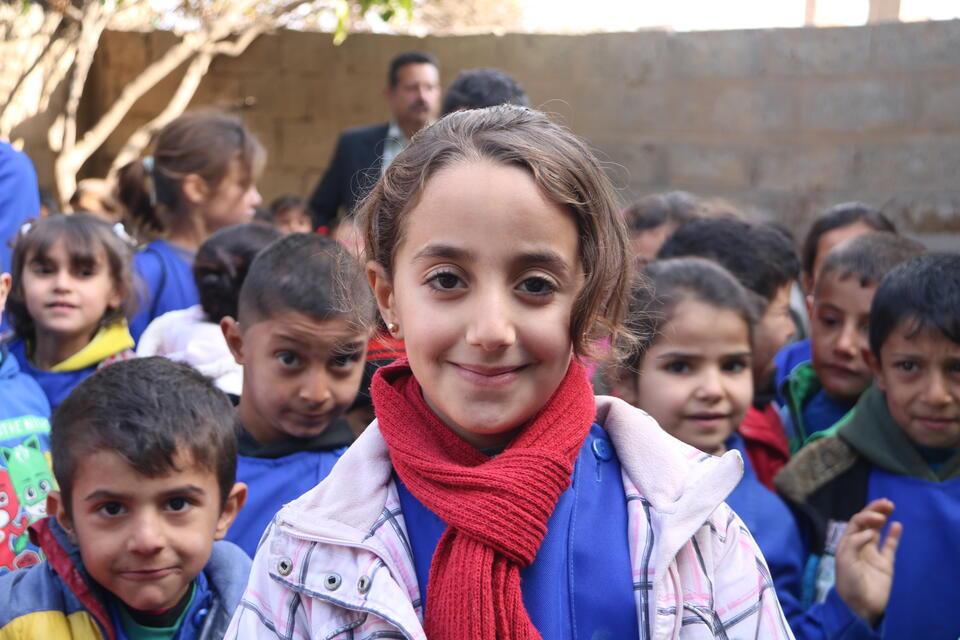
Donate to Syria
From earthquakes to over a decade of war, an unending series of crises threaten Syrian children's rights to grow up healthy, hopeful and safe. Here's how UNICEF is working to give them the health care, education, safe water and protection they need to reach their full potential.
“Seeing my only boy’s health deteriorate every day was the hardest thing for me," recalls Ateka, a mother who lives in Syria. The day she brought her son, Ghassan, to a UNICEF clinic for help, the 2-year-old couldn't walk or play. The diagnosis was severe wasting. "I don’t want to think about those days.”
In Syria today, Ghassan's condition is all too common. Ghassan and Ateka are from Deir ez-Zor, the biggest city in eastern Syria. Years of intense fighting have crippled Deir ez-Zor's public infrastructure. The sky-rocketing price of food and other essentials means parents like Ateka need help to make ends meet.
Syria's children are paying the price of over a decade of war. But thankfully, UNICEF is on the ground working to protect their rights.
At clinics in Deir ez-Zor and across Syria, children can receive ready-to-use therapeutic food (RUTF), UNICEF's go-to treatment for malnutrition. A dense nut-based paste, RUTF is rich in all the essential nutrients, minerals and vitamins children need to recover.
At the health center he visited, Ghassan got a five-month course of treatment with RUTF along with other health services. Now he is over 3.5 pounds heavier and on the road to recovery.

Donate to help children in Syria
Twelve years of fighting has had a far-reaching, devastating impact on children's lives and prospects.
Today, with no end to the conflict in sight, over two-thirds of people in Syria urgently need assistance. That is the greatest number of people requiring humanitarian aid since 2011.
With the country struggling to recover from February's earthquakes and aftershocks, the challenges for Syria's children and their families are even greater.
Limited job opportunities have pushed over 90 percent of families into poverty. With prices sky-high and bare market shelves a fact of life, over half of Syria's families don't know where their next healthy meal will come from.
Amidst the depravation, the missile attacks and bombings continue uprooting families. Many have moved multiple times, seeking safety and a better life.
Today, over 6.5 million people are displaced within the Syrian Arab Republic. Some 5.6 million people live outside Syria as refugees in Egypt, Iraq, Jordan, Lebanon and Turkey. Of them, 2.6 million are children growing up in refugee camps, informal settlements and slums.

The current situation in Syria
On February 6, the deadliest earthquake in Syria's history struck. The 7.8 magnitude quake and subsequent aftershocks also hit neighboring Turkey. Seeing their loved ones killed and injured, their communities and homes destroyed, families already in crisis spiraled even further into despair.
The earthquakes combined with the social and economic repercussions of war make Syria one of the world's worst places to be a child.
Poverty, especially in households headed by women, has heightened risks of early marriage for girls, along with child abuse and exploitation.
The public safety net is in tatters. Before the earthquakes inflicted further damage:
- just half of the primary health care system functioned with an estimated 20,000 doctors. The recent cholera outbreak and earthquakes have placed additional burdens on health centers still operable.
- only two-thirds of schools are fully functional. Many were destroyed or now shelter displaced families.
- roughly two-thirds of the nation's water treatment facilities, half of its pumping stations and one-third of its water towers were destroyed by conflict

Challenge for Syria's children
Now more than ever, millions of Syrian children need relief from unrelenting violence, exploitation, deprivation, trauma and loss.
After years of missile attacks, landmines and unexploded ordnances are a common threat. Since the start of the Syrian conflict, war has injured and taken the lives of 13,000 children
Due to chronic undernutrition, stunting affects 600,000 children under 5. The impaired growth and development can lead to permanent damage
War has created one of the largest educational crises in recent history. Nearly 2.5 million children are out of school in Syria
What is UNICEF doing to help children in Syria
UNICEF works tirelessly, with partners across Syria and its neighboring countries, to help Syrian children and their caregivers. In 2022, UNICEF:
- helped 1.9 million children and women access primary health care in UNICEF-supported facilities
- helped 3.8 million people access a sufficient quantity of safe water
- supported 1.3 million children with education services in formal settings
- provided micronutrients to 2 million children and pregnant women and breastfeeding mothers
- reached more than 220,000 children with mental health and psychosocial support
- reached more than 1 million people with explosive hazards risk education
Your support can help UNICEF reach even more children caught in conflict in Syria and worldwide with lifesaving humanitarian aid. Please donate today.